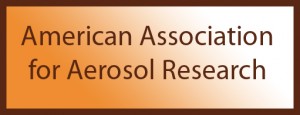 More talks of interest from the AAAR meeting coming up in a couple of months. Previous posts about this meeting can be found here, here, and here.
More talks of interest from the AAAR meeting coming up in a couple of months. Previous posts about this meeting can be found here, here, and here.
Phylogenetic-based Fungal Population Comparisons of Dust Collected from Water-damaged and Nonwater-Damaged Homes
KAREN DANNEMILLER, Jordan Peccia, Yale University
Abstract Number: 327
Working Group: The Indoor Microbiome
In the 5MB.2 session on Wednesday from 1-3pm in the Lake Superior room
Abstract
The presence of dampness or visible mold in homes is a consistent risk factor for respiratory infection in children, and is associated with the development of asthma, asthma exacerbation, and allergic rhinitis. The quantity and diversity of fungi in house dust has commonly been measured using culture-based techniques, which are known to introduce biases due to the unknown viability and limited culturability of allergenic fungal fragments. This work seeks to improve current fungal allergen quantity and diversity assessment in homes by using DNA-based, phylogenetic techniques. The main objective of this work is to produce quantitative, molecular-based microbial diversity descriptions of indoor dust samples collected from 200 homes in the Northeastern US. Many of these homes have documented water damage or mold growth, thus allowing for a comparative assessment. Phylogenetic libraries were created using 454 pyrosequencing of extracted DNA from all samples and by targeting both the internal transcribed spacer (ITS) genetic region for accurate species-level identification, and the rRNA large subunit (LSU) gene region to allow for alignment and comparison of populations based on phylogenetic distances. In addition, six selected species, human DNA, and universal fungal genomes were quantified by qPCR. Results will be presented that reveal associations between water and non-water-damaged homes both in terms of overall population differences, as well as statistical determination of species that are uniquely associated with water damage. Beyond these tangible outcomes, this work will provide information towards the establishment of safe mold level guidelines that reduce the risks of allergenic, infectious, and asthmatic disease.
The second presentation will be during Session 2 onTuesday, 1:00 PM – 3:00 PM with paper Number: 2.MB.8. It has the following title and abstract:
The Floor Dust-Indoor Air Continuum: A Microbial Community Perspective
DENINA HOSPODSKY, William Nazaroff, Jordan Peccia, Yale University
Abstract Number: 728
Working Group: The Indoor Microbiome
Abstract
Humans spend approximately 90% of their time indoors, where inhalation of microbial constituents is a significant exposure route. Through combining indoor air modeling efforts with molecular biology-based microbial population assessments, previous research has suggested that human occupancy shapes the indoor air microbiome, mostly through resuspension of bacteria contained in floor dust. The goal of this study is to examine how independent parameters including human activity, air exchange rate, floor dust load, and relative humidity, influence the contribution of floor dust bacteria to the bacterial species found in indoor air.
Floor dust and indoor aerosols were sampled in six classrooms in the US (1), Europe (3), and China (2) during times of occupancy. Phylogenetic libraries based on the 16S universal bacterial gene were produced for floor dust and air samples using 454 pyrosequencing technology. Retrieved sequences were assigned to phylotypes and the differences between floor dust and air populations were quantified via their weighted UniFrac distance metric. A low (near zero) distance metric indicates that the floor dust and air populations are identical (i.e., demonstrating a strong floor dust source contribution). We investigated linear correlations between this UniFrac distance metric and independent parallel measured variables including air exchange rate [h-1], relative humidity [%], floor bacterial load [genomes m-2], and the intensity of occupants’ activities [W m-2 h-1].
Results demonstrate that an increase in floor dust contribution (lower UniFrac distance) was strongly correlated with increased human activity (Pearson correlation, r = -0.67) and bacterial floor dust load (r = -0.57), and moderately correlated to increased relative humidity (r = -0.39). Decreased source strengths of the floor dust were moderately correlated with increasing air-exchange rate (r = 0.43). Multivariate statistics analysis will be presented to identify the combination of building parameters that most confidently predicts the resuspension of microbial communities from the floor to the air.
Jordan Peccia will be giving a tutorial on Monday, October 8, from 8:00 – 9:45 AM.
Tutorials are Pre- Conference Sessions. There is an additional fee for each tutorial.
Molecular Biology-Based Bioaerosol Analyses
Jordan Peccia, Department of Chemical and Environmental Engineering, Yale University, New Haven, CT
Abstract: This tutorial covers molecular biology concepts and tools that are relevant for the analysis of airborne biological material. The course begins with a targeted introduction to genetics, phylogenetics, and bioinformatics for aerosol scientists that have a limited background in biology. Next, molecular biology-based methods that are useful for the quantification, identification, and population characterization of bacteria, fungi, and viruses in aerosols will be presented along with examples. These methods include polymerase chain reaction (PCR), quantitative PCR, immunoassays and proteomics, and next generation DNA sequencing to produce phylogenetic libraries. The course will conclude with an overview of sampling strategies that can be integrated with molecular biology-based analysis, and information on the quantitativeness of the above methods.
Jordan Peccia is an associate professor of chemical and environmental engineering and the environmental engineering director of undergraduate studies at Yale University. His research group integrates molecular biotechnology with process engineering to address environmental problems. Dr. Peccia has over 15 years of experience in applying molecular biology to assess the sources, the diversity of, and the exposure to airborne bacteria, fungi and viruses in the atmosphere and in indoor environments. He earned his PhD in environmental engineering from the University of Colorado in 2001.
for more information, http://2012.aaar.org/tutorials#Molecular_Biology_Base